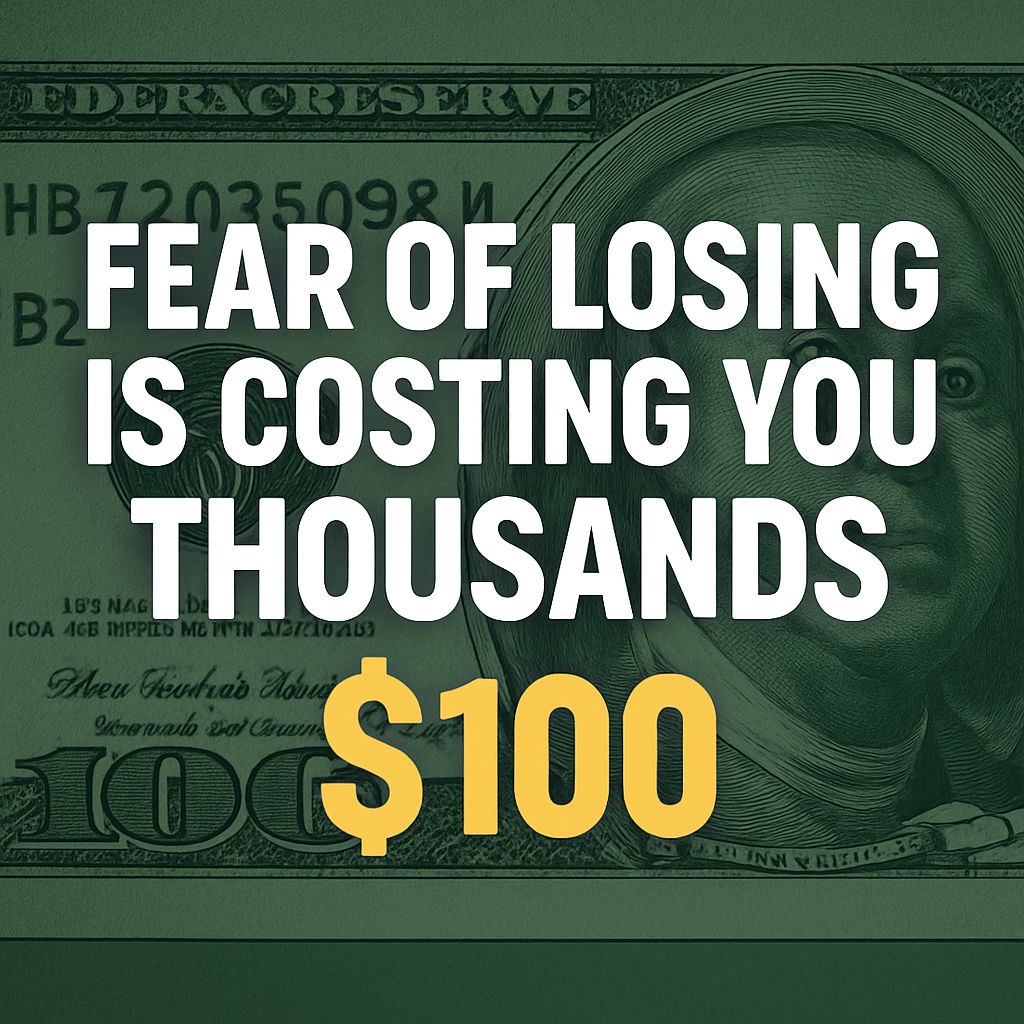The average American loses over $300,000 in lifetime wealth by avoiding the stock market. If you are still afraid to invest, this could be the most expensive fear you ever hold onto and it is when you know investing creates millionaires.
Why am I afraid to invest?
Most people feel afraid to invest because losses trigger the same fight-or-flight response as real danger. Pair that with limited financial know-how, scary headlines, and past money slip-ups, and your brain shouts, “Stay safe!” Understanding that volatility is normal—and learning the basics—shrinks that fear fast.
Meet Sarah—Your Inner Saboteur
Sarah stared at her brokerage app like it was a haunted house. Every time she clicked “Buy,” her heart raced, palms sweated, and she half-expected a tiny stockbroker ghost to pop up saying, “I told you so.” Sound familiar? If you are Afraid to Invest, you’re not alone—and you’re definitely not broken.

In this post, we are going to:
• Unpack why investing feels risky
• Share the mindset shift that made millionaires (yes, it is more mental than monetary)
• Give you investing tips for scared beginners
• Offer a beginner’s guide to investing with safe investments for first-time investors
• Show you how small moves can have big returns
Ready to trade fear for freedom? Let’s dive in.
The Biology of Fear: Why We are Wired to Hesitate (Your Brain vs. Your Wallet 🧠💸)
Our ancestors survived by fearing sabertooth tigers, not stocks. That same lizard brain still kicks in when you see your portfolio dip. That jitter? It’s your amygdala throwing an IPO of panic.
• Fear of losing money in stock market is emotional, not rational.
• The Fear and Greed Index swings between 0 (panic) and 100 (euphoria)—and most retail investors buy when it’s high and sell when it’s low.
“The stock market is filled with individuals who know the price of everything, but the value of nothing.”
– Philip Fisher
Understanding this wiring is the first step toward controlling it.
Master Your Money Mind: The Psychology Behind Share Investing 👉 Investing in Shares~ Hobby, Need, or Addiction? 6 powerful Lesson
Millionaire Mindset: From “I Can’t” to “I Will”
Legendary investor Warren Buffett once said, “Be fearful when others are greedy, and greedy when others are fearful.” But before you start scouring for a bargain basement ticker, absorb the real lesson:
1. Acceptance: Accept your fear is normal. Even Buffett felt jitters—he just ignored them.
2. Commitment: Decide investing is non-negotiable, like brushing your teeth.
3. Curiosity: Replace “What if I lose?” with “What if I learn?”
Imagine treating each dip like a discount sale, not a disaster. Suddenly, you are shopping for bargains, not running from danger.
🔢 5️⃣ Actionable Steps: How to Overcome the Fear of Investing
How can I overcome the fear of investing?
Start small with low-risk assets, educate yourself on market basics, automate contributions, and reframe market dips as opportunities. Over time, experience and discipline replace fear with confidence.

1. Educate, Don’t Intimidate
• Read one article a day about stocks, bonds, or funds—no finance degree needed.
• Watch 10-minute explainer videos on YouTube: think of it as binge-learning rather than binge-anxiety.
2. Start Small, Scale Fast
• Open a micro-investing account and put ₹500 aside weekly.
• Even small investments with big returns strategies like fractional shares can deliver real growth (and real confidence).
3. Automate Your Courage
• Set up an SIP (Systematic Investment Plan) to invest automatically each month—out of sight, out of mind, out of fear.
• The routine builds discipline, not doubt.
4. Diversify Your Fear
• Mix equities, debt funds, and gold ETFs so one bad apple doesn’t spoil the barrel.
• Safe investments for first-time investors include short-term bond funds and large-cap mutual funds.
5. Track, Don’t Tally
• Check your portfolio quarterly—not daily.
• Use an app that shows growth over months, not minutes, so you remember you’re in it for the long haul.
A Beginner’s Guide to Investing: From Zero to Hero
You have read the steps—now let’s map out your journey with a beginner’s guide to investing roadmap:
Stage |
Action Item |
Why It Helps |
|
Foundation |
Build an emergency fund of 3–6 months |
Peace of mind before you take risks |
|
Education |
Learn the basics: stocks, bonds, funds |
Curbs shock when markets move |
|
First Buy |
Invest in a large-cap mutual fund / SIP |
Broad exposure, lower volatility |
|
Growth Phase |
Add small allocations to sector ETFs |
Target growth, diversify risk |
|
Rebalance |
Once a year, rebalance to your ideal mix |
Keeps you on track, not on edge |
The “Pizza Portfolio”
Your Real-Life Analogy
Think of your portfolio like a pizza:
• Crust = Safe core (government bonds, short-term funds)
• Sauce = Steady growth (large-cap equity funds)
• Toppings = Spicy bets (small-cap funds, thematic ETFs)
If you overloaded your pizza with ghost pepper, you’d burn out. Similarly, an all-small-cap portfolio can scorch your nerves. Balance your “toppings” to keep things tasty and tolerable.

Investing Tips for Scared Beginners
Below are investing tips for scared beginners to carry in your back pocket:
• Embrace DCA: Dollar-cost averaging reduces the stress of market timing.
• Keep Cash Alive: Holding 5–10% in cash cushions sharp market swings.
• Set “Fear Triggers”: Predefine a strategy (e.g., add 10% more when Nifty drops 10%).
• Focus on Goals, Not Gains: Think “Education fund for Emma,” not “return.”
• Celebrate Small Wins: A 3% gain is still a gain—confetti time!
The Fear & Greed Dashboard 🏁
The Fear and Greed Index distills seven market indicators into one number between 0 and 100:
| Index Level | Market Mood | Smart-Money Move |
| 0-24 | Extreme Fear | Keep buying on schedule |
| 27 | Fear | Top up your core fund 2 % extra |
| 38 | Mild Fear | Stay the course; maybe rebalance |
| 50 – 74 | Greed | Check allocation creep |
| 75 – 100 | Extreme Greed | Consider trimming winners |
Remember: when headlines scream panic, valuations whisper opportunity.
Real-Life Wins 🌟
Maya, 41, Teacher
Started a $150 monthly automatic investment in 2018. She ignored a 2020 plunge and a 2022 mini-recession. Her account: $17,800, up 38 %. She calls it “my freedom fund.”
Carlos, 33, Barista turned UX Designer
Bought fractional shares worth $50 a week via an app. Five years later: $15,200—enough to cover a down payment on a used Tesla.
Lesson: They weren’t luckier or smarter; they were just less flaky with their deposits.
🧠 Addicted to Buying Stocks? Or Just Mistaking Greed for Strategy?
Believe it or not, being afraid to invest is not the only risk—being addicted to buying stocks is it’s chaotic twin. The thrill of market action, the high of a green candle, or the rush of “beating the market” can quickly become compulsive.
If you find yourself checking stock apps more than social media, or buying into any dip without a plan—pause. Investing should feel calm, not like a casino.
Pro Tip: Follow the “Plan → Research → Execute → Ignore” formula. It keeps you strategic and shields you from turning investing into obsession.
🎯 Bonus Tips: 8 Advanced Hacks to Fear-Proof Your Portfolio
1️⃣ Run a “What-If” Fire Drill
Firefighters rehearse before flames erupt—and investors should too. Open a spreadsheet and slash every holding by 30 %. How does your net worth look? Now script your response: “If my portfolio drops 30 %, I’ll rebalance by buying 5 % more equities and pausing big discretionary buys.” Practicing the pain rewires your brain; when real volatility hits, you’ll act from a prewritten plan, not panic.
2️⃣ Use the 3-Bucket System
Separate accounts into:
• Safety (1 year expenses in cash + short-term Treasuries)
• Growth (core index funds + bond ETF)
• Opportunity (sector or thematic ETFs, individual stocks)
See? Your future isn’t one swirling pot—it’s buckets with lids. Fear hates boundaries; give it some.
3️⃣ Gamify Dollar-Cost Averaging
Turn investing into a quest. Each month you invest on schedule, award yourself points (or a $10 treat). Miss a month? Zero points. Pair this with a public tracker—say, a shared Google Sheet with a friend. Visibility turns discipline into sport, making fear less of a monster, more of a scoreboard obstacle.
4️⃣ Leverage “Mental Stop-Losses”
Instead of hard stop-loss orders that might kick you out at the worst time, deploy mental stop-losses: thresholds that trigger research, not selling. For instance, “If XYZ dips 20 %, I’ll reread the annual report and check revenue trends.” Often you’ll find nothing has fundamentally changed—only the sticker price. Knowledge neutralizes knee-jerks.
5️⃣ Create a Future-Self Vision Board
Tape a picture of that mountain cabin or college diploma (for your kid) above your desk. Underneath, note how much monthly investing accelerates the timeline: “At $400/month compounded 8 %, cabin in 12 years; at $600/month, cabin in 9.” Tying numbers to vivid images flips fear into impatience—in the best way.
6️⃣ Practice Progressive Exposure
Psychologists treat phobias by gradual exposure. Do the same with money risk:
• Week 1: Read a stock chart daily.
• Week 2: Create a watch-list.
• Week 3: Buy $50 of an ETF.
• Week 6: Increase to $200/month auto-invest.
Each tiny success files a new neural “win,” shrinking your fear footprint week by week.
7️⃣ Build an Investing “Board of Advisors”
You don’t need Warren Buffett on speed dial—just three reliable voices:
- The Veteran: friend or colleague who’s ridden at least one full market cycle.
- The Analyst: a podcast host, newsletter author, or CFP whose logic you trust.
- The Accountability Buddy: someone at the same starting line as you.
Group-chat once a quarter. Discuss wins, worries, and allocation tweaks. Community turns solitary fear into collective learning.
8️⃣ Review the “Regret Test” Before Every Trade
Ask two questions:
1. “If I don’t buy and the price doubles, will I regret it more than if I buy and it halves?”
2. “Does this decision leave Future-Me proud or apologizing?”
Whichever scenario provokes less regret is usually the rational path. The test anchors you to long-term satisfaction, not short-term mood swings.

FAQs: (Frequently Asked Questions)
1. Should I continue investing even though I have a fear of losing money?
Absolutely. Fear is a signal, not a stop sign. A small allocation each month keeps you moving forward while monitoring your comfort zone
2. What exactly is the Fear of Losing Money Phobia?
It’s a paralyzing worry that any loss—even temporary—means you’ve failed. Naming it helps you tame it.
3. What is a Fear and Greed Index?
A gauge (0–100) of market emotion. Below 20 = panic, above 80 = greed-fest. Use it to time your entries and exits.
4. How do I avoid making investment decisions based on fear?
Automate contributions, set rules for buying/selling, and check your portfolio infrequently.
5. Why are common people afraid to invest in mutual funds/SIPs?
Lack of knowledge, past stories of friends losing money, and confusing jargon. Education cures confusion.
6. Is it a good idea to keep investing after losing money?
Yes—markets historically recover. Continuing your SIP after a dip buys you at lower prices (hello, bargain!).
7. What should I do if the fear of not having enough money arises?
Revisit your emergency fund and adjust your allocation to add more safe assets until you feel stable.
8. How do you deal with being afraid of losing control of your money?
Use robo-advisors or sub-accounts: delegate the day-to-day so you focus on big-picture goals.
9. Do you agree that greed and fear are the basis of the stock market?
Entirely. Stocks rise on optimism (greed) and fall on panic (fear). Learn to ride both tides.
10. How can I overcome the fear of investing in volatile markets?
Understand volatility equals opportunity. More volatility often means steeper bargain sales.
Your Next Steps: Act Today
• Open a micro-investing account and automate ₹500/month.
• Bookmark one finance blog post and read it this week (we hear Passive Income Strategies That Work is a hit).
• Write down one fear you have about investing and one action step you’ll take to face it.
Being Afraid to Invest today is normal; staying afraid in five years is optional. Plant that first $100 seed now and let compound interest throw the biggest surprise party for your future self.
Ready for the next level? Check out our deep dive on Passive Income Strategies That Work—because money you do not sweat for is the sweetest victory.







